Beginning aquarists even before they have the first tank, think about what it will be. The design of the aquarium is an interesting direction, in addition, today there are a lot of ways to decorate it. One of the most interesting options for decorating a tank is to design a herbalist aquarium.

What it is?
So called capacity with an abundance of various underwater plants, the main emphasis is on vegetation, and not on fauna. Moreover, there may not be any fish in such a container at all. But growing underwater gardens is no less interesting than observing the life of marine life. The herbalist aquarium is a broad concept, it also includes a traditional artificial pond with living species of flora, and a Dutch-style container where vegetation is grouped by shape and color. Belongs to herbalists and beautiful aquascape - a manual imitation of underwater landscapes.

Such constructions are slow or "lazy." This is the name of water bodies where plants live much slower than in forced ones.
This effect can be achieved if the supply of carbon dioxide is minimized (or completely abandoned). You can also set moderate lighting in the aquarium design, limit the introduction of fertilizers into the water, or even cancel them altogether if there are enough fish and other inhabitants in the aquarium. Not all plants can survive in the popular slow herbalist: long-stemmed and fast-growing variants in such conditions die. The best choice is ferns and mosses, which are not very fast growing and have a small demand for lighting.Any kind of cryptocoryne, anubias and wallisneria can also become an elegant decoration of the herbalist.
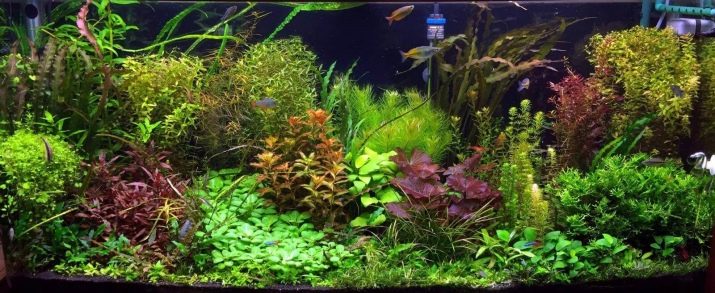
Shape and size options
The reservoir for the herbalist is usually taken no higher than 50-60 cm. If the height is greater, problems with caring for the plants will begin, and the light will not be able to penetrate to the full depth. A round aquarium is not the best option for beginners. Aesthetically, it is beautiful, but in terms of operation it is inconvenient. A rectangular container is most preferred. Typically, such aquariums are sold with built-in lamps. But if they are not there, you need to install the lamp so that there are no dark areas.
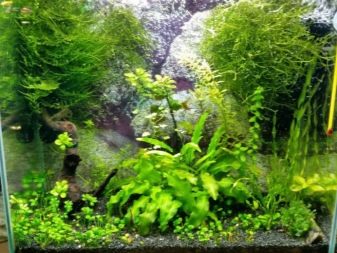
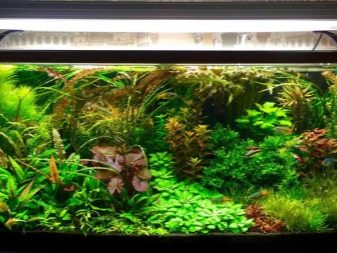
The width of the aquarium should be at least 50 cm. If the dimensions are small, the depth of view will be lost.
If the aquarium is presented at 40-50 liters, the species diversity of plants and fish will be more scarce in it than in a tank of 100, 150 liters, and even more so - 500 liters. Herbalist usually arrange in a fairly large capacity, rectangular, well-lit, easy to care for. Most often they make it from a former classic aquarium, in which the main emphasis was on fauna. It’s great if you don’t buy a ready-made option, but do it yourself. It is difficult, thorough informational preparation is required, but the result is worth it.
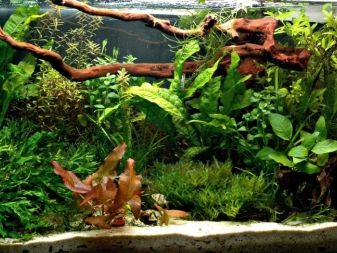
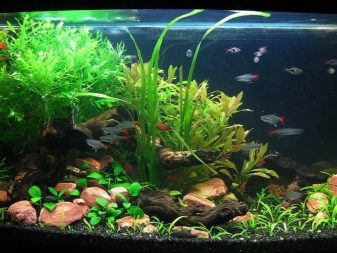
How to make?
A step-by-step instruction for beginners involves several subtopics that describe the requirements for each element of the herbalist.
Lighting
Lamps should be with a predominance of the red spectrum, responsible for the growth and development of plants. For flowering, the blue-violet spectrum is responsible. It is customary to install a blue lamp at the front wall of the aquarium, a red lamp at the back wall and in the center. Usually they are combined with full-spectrum fluorescent lamps.
It is mandatory to adjust the lighting power - you need to make it as cyclical as natural: a powerful color lasts for 3-4 hours, after which it is changed to moderate.
This is done using a combination of light sources (LEDs, searchlights, etc. are used). LED lights are installed according to the rule 1 Watt is needed per 1 liter. Daylight hours - 10-15 hours. By the way, illumination of a freshwater aquarium is considered to be in lux - lumen / area.

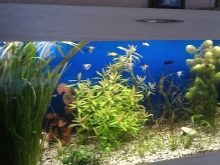

Water
The herbalist should include heating engines and a temperature regulator. Their use provides the optimum temperature range - + 24– + 26 degrees. This temperature organizes the required concentration of CO2 and oxygen. If the temperature in the herbalist is increased, the latter will overgrow with algae. For a tank with plants, carbonate, and not the total hardness of distilled water, is important, its indicator is 4.

If the pH is lower, the amount of carbon dioxide increases.
From time to time, fertilizers (liquid and mineral) are introduced into the water, and with their help, the concentration of iron is maintained. You can control the quantitative indicator of nitrites with test strips - if the ammonia parameter is excessive, this can destroy the biosystem. Change water every 8-10 days (about 40%). Such actions can reduce organic accumulation.
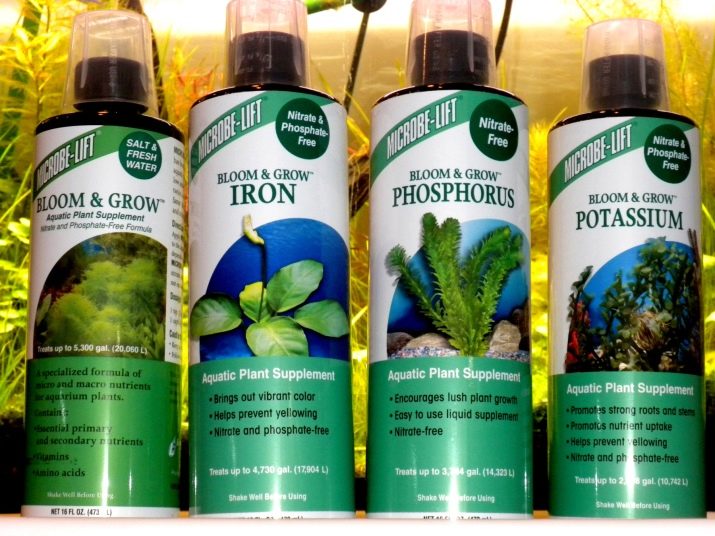
Priming
To fill the tank, a nutrient substrate, soil with nutrients and a standard substrate are used. Basalt chips, quartz sand or pebbles are considered to be empty soil; there are no nutrients in it. Medium-sized soil is optimal for the herbalist, in which beneficial bacteria develop well. The soil must be washed before running into the aquarium (to eliminate impurities and foreign substances).
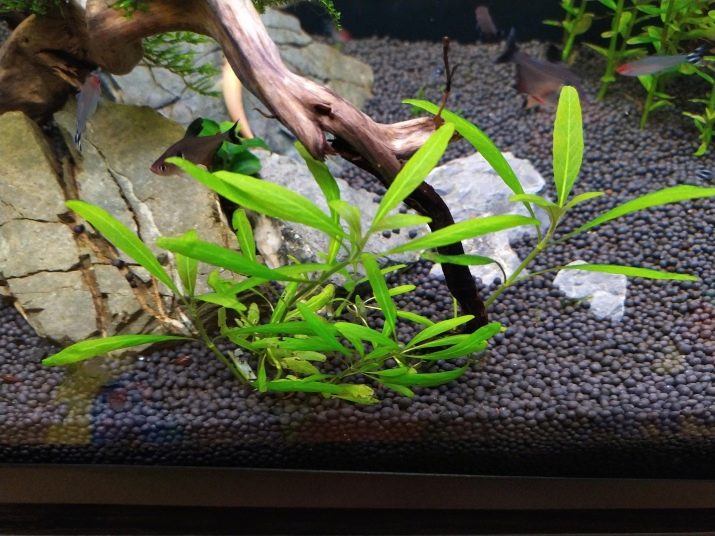
At the initial stage, the soil is sterile, it takes some time for it to silt.
When the substrate is filled up, settled water is poured into the aquarium - planting of vegetation is carried out after some time. Water design involves the launch of both decorative and nutritious soil. In the future, there you can create a whole composition with the establishment of stones, driftwood, pick up sunken ships and so on.
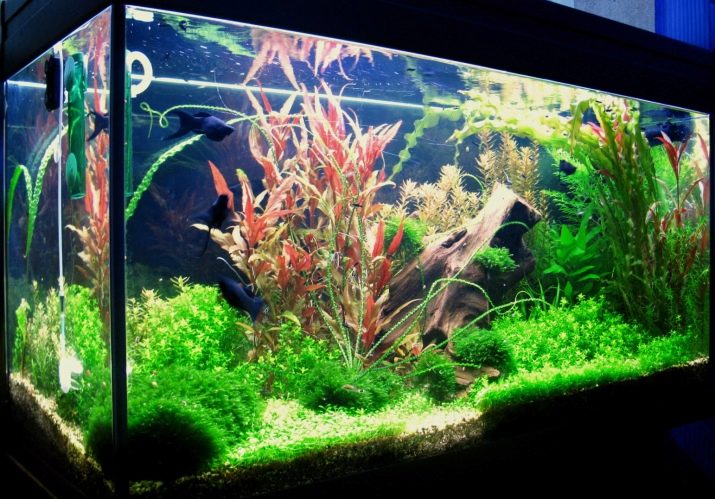
Launch features
The whole process can be divided into 6 stages. Each of them is multi-stage, but the overall sequence is unchanged. Instructions for beginners to start the herbalist include several stages.
Planning
A blank sheet and a pencil - this is where the work begins. Make a sketch of how the aquarium will look: where to plant tall plants (along the back wall), where to put decorative elements, where to plant a little green grass. You can draw interesting ideas from aqua designers or even turn to them for advice.
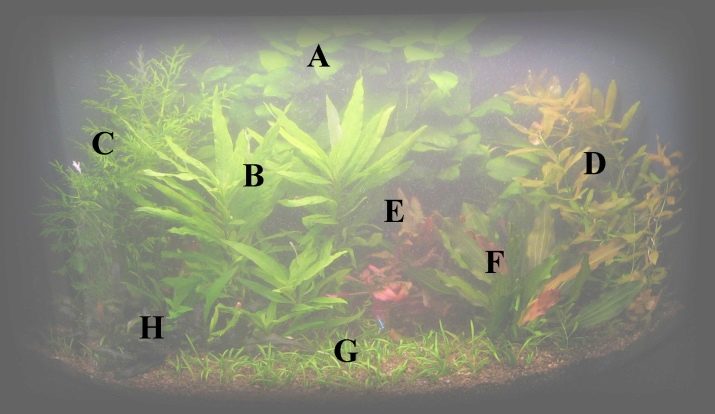
Soil and substrate
We fill up the substrate first, then the nutrient soil - this is the basis of the herbal aquarium.
As a substrate, a special lava is suitable, it can be bought at a pet store.
After falling asleep, a nutrient soil is introduced, which will stimulate plant growth for a long time. And only on top of this layer is decorative soil. The foundation is ready.
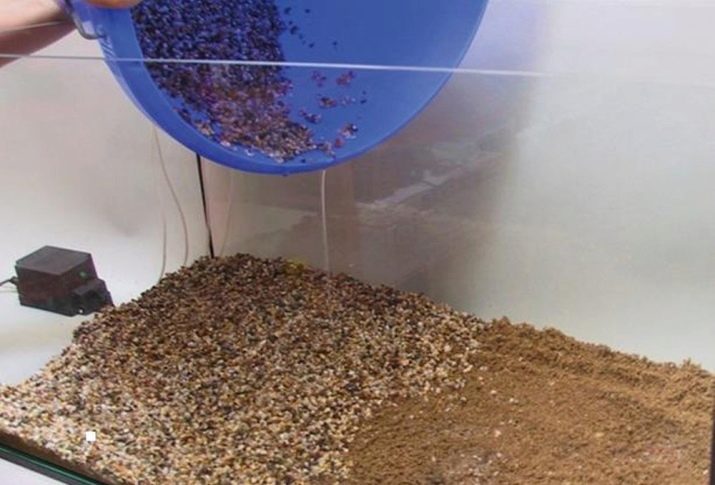
Decor and water preparation
Now you can install driftwood and stones, ships (everything that your plan suggests). The water that you will pour in must be defended for at least 24 hours in order to weather chlorine out and warm it to room temperature. You can use special water conditioners that remove harmful impurities from the liquid. For aquascape, reverse osmosis is required.
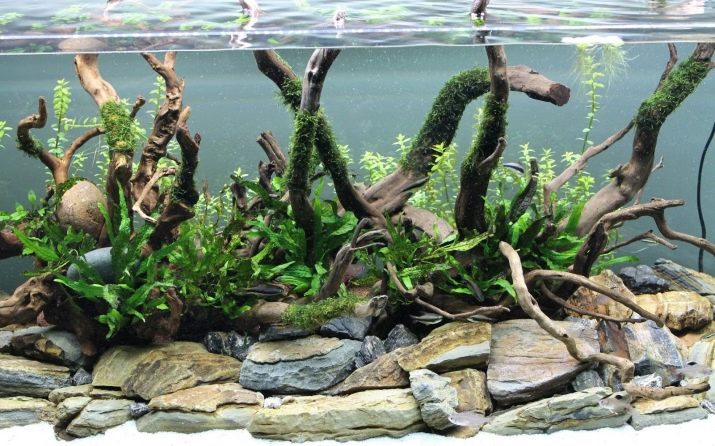
Water fill
The aquarium is filled with water up to about half to avoid erosion of the soil.
Before filling, place a plate in the tank, where and direct a stream of water.
The main requirement for a stream of water is not to destroy the litter and soil in the herbalist. Now you can add a bacterial preparation to the water, which boosts the establishment of a healthy bio-balance.
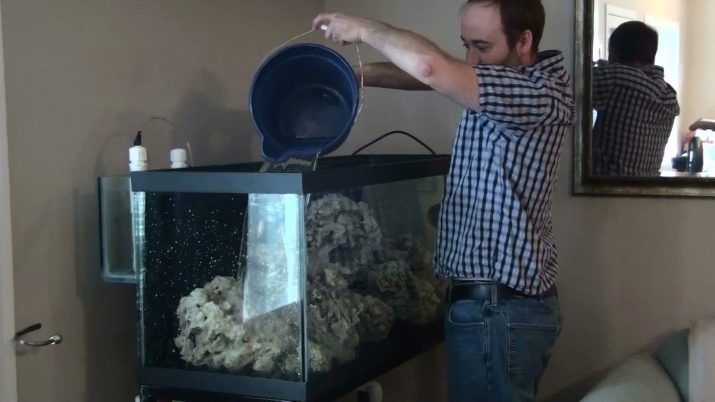
Planting plants
Planting is also carried out according to plan. To model the height of the future composition, wooden sticks are taken, which are fixed at the places of future planting.
Before planting, the roots are pruned.
You need to plant plants with special tweezers, which simplifies the already painstaking process. If the aquarium is large, then the flora should be sprayed with water from a spray bottle from time to time so that its leaves do not dry.
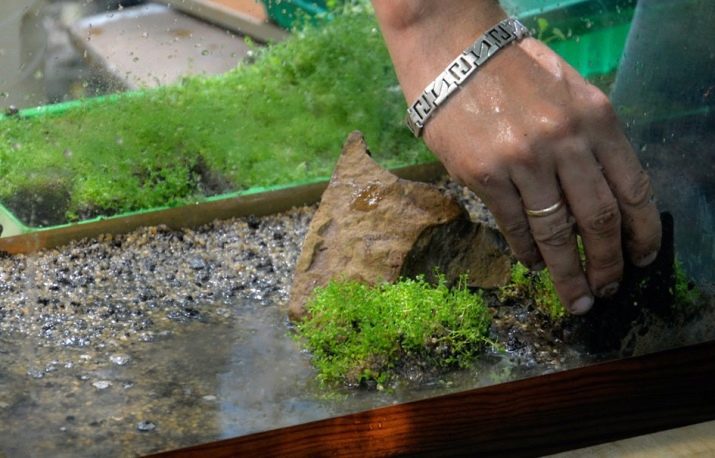
Equipment installation
Now you need to fill the tank with water completely. The filter is connected (preferably external). Further, if you are going to hook fish, then you need to wait three weeks. After this time, conditions suitable for their existence will form in the herbalist. You can add shrimp in three weeks. The lamp in the herbalist first works 6 hours a day, then the time increases to 10-12 hours. The compressor always works at night, during the day if the fish require it.
Important! Three weeks you follow the system. If all its devices (filter, lighting) are working properly, if the water is clean and its temperature is normal, you can start the fish.
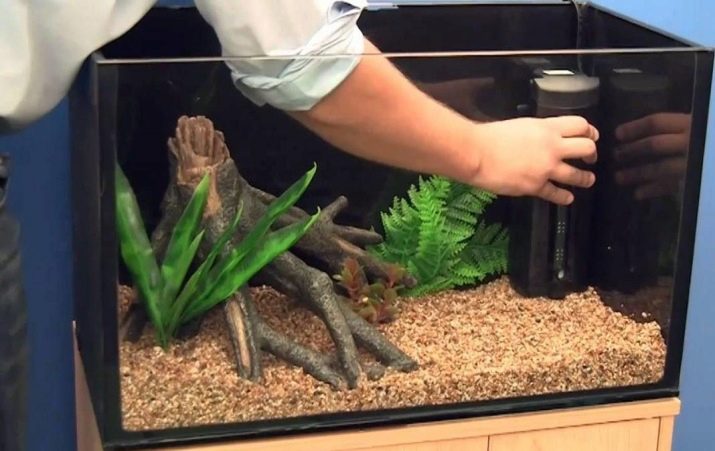
How to care?
To grow a beautiful herbalist, you need to monitor compliance with biobalance in it. Even a lack of potassium or the launch of the wrong fish (for example, goldfish) into the reservoir can adversely affect the state of the entire ecosystem in the tank. Check the condition of the water, evaluate its transparency, use test strips to determine the composition. Assess the performance of fixtures, filters, and so on. Replace water promptly.
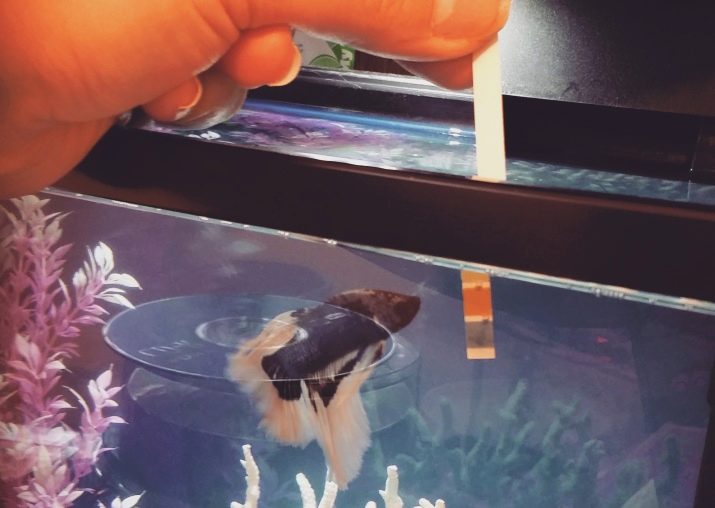
Speaking specifically about plants, it is important to correctly fill out all plans to create high-quality aqua design.
It is worth adhering to the following rules for planting vegetation:
- requirements for the content of planted flora should be the same;
- before planting, the plants are inspected for rot and deformation;
- first, the center of the aquarium is filled with plants, then the foreground and background;
- at the planted flowers, leaflets and roots are cut;
- fertilize water in a timely manner.
In the herbalist there may be a place for moving scenery.
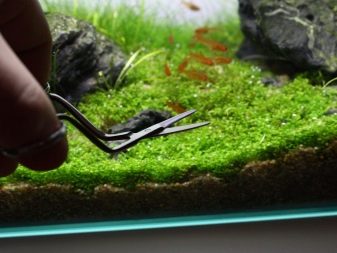
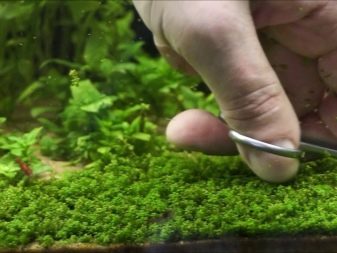
So called, for example, copies of jellyfish that move in the water stream.
They are made of special silicone, fastened by jellyfish with nylon threads or suction cups. In the dark, these figures phosphoresce, so it seems that real jellyfish swim in the aquarium.
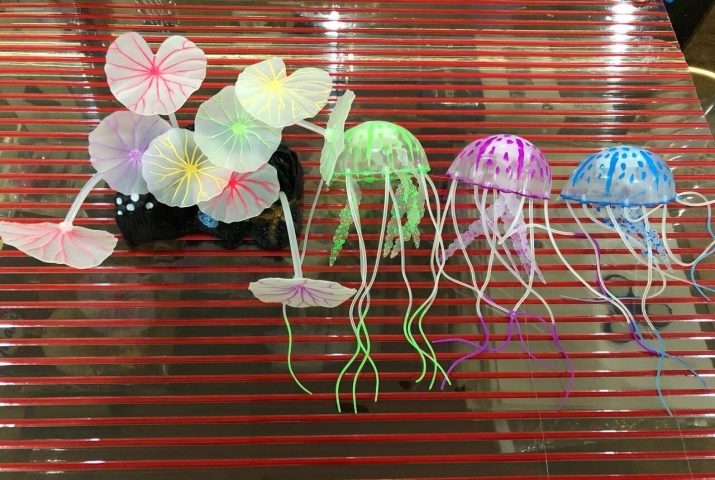
How many and what kind of fish can I keep?
In an aquarium with picturesque and lush vegetation, haracial ones will feel good, the most preferred are flocking species. This list includes neons, rassbori, tetras and rhodostomuses. So that the walls of the tank can be cleaned of algae in a timely manner, catfish-ancistruses, as well as Siamese algae eaters, can be launched into the herbalist. It is important that the fish do not touch the plants and are in good proximity to each other.
These are just the basics of aquascaping, elementary actions that should be familiar to beginners. Growing a garden under water is not an easy process.

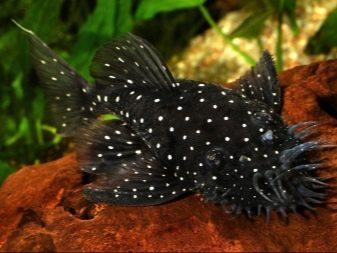
A huge number of those who took up this work quickly “turned fishing rods”. In order to maintain all the conditions necessary for plant growth and fish life, you have to constantly monitor the condition inside the tank, the indicators of water and CO2, lighting and soil. Those who are not ready to do aquarium work so seriously should better turn to artificial (dry) aquariums, which have also become popular recently.
On the intricacies of the content of the herbalist’s aquarium, read on.










